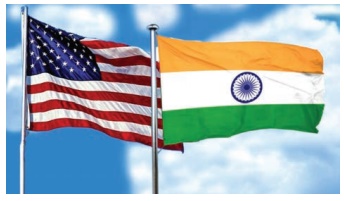Chapter: 12th Political Science : Chapter 9 : India and the World
India-United States of America (USA) Relations
India-United States of America (USA) Relations

History
Formal political relations with the USA began
during World War II. The first exchange of envoys, Thomas Wilson and Sir Girija
Shankar Bajpai, took place in 1940 which resulted in the establishment of a
diplomatic office in Delhi.

It was not until 1946, under the presidency of
Harry S Truman, that the full-fledged diplomatic relations emerged between
India and the US. This was consolidated further after India became independent
in 1947.
During the partition, Kashmir, acceded to India,
which Pakistan contested. Pakistan claimed that this accession was done
forcibly by India. This issue was taken up by the United Nations for discussion
in 1948, as a result of which, a U.N. Commission for India and Pakistan (UNCIP)
was set up. India was stated that this was a ŌĆ£completely wrongŌĆØ move and
strongly criticised USA and U.K for their role. NehruŌĆÖs first visit to the
United States followed soon after the formation of the commission.

Devoid of personal rapport between the heads of the
two states and mutual criticisms, the gap between India and USA further
widened. Things did not improve with the formation of an American sponsored
alliance system - SEATO (South East Asian Treaty Organization) and CENTO (Central
Treaty Organization). PakistanŌĆÖs inclusion in the organisation and the
resulting US-Pakistan military pact left little hope for any improvement in the
bilateral relations. Although there were small periods of a better environment
in the second term of Eisenhower and during KennedyŌĆÖs term, it was still a very
long way from ŌĆśall-weather friendlyŌĆÖ ties.
The USA tried to interfere and influence IndiaŌĆÖs
domestic (economic) programmes when India sought economic and technical
assistance from her for industrialization.
Under PL480, five agreements were
signed between India and USA for supply of agricultural commodities to India in
1954.
Post-Cold War Relations
Fifty years after IndiaŌĆÖs independence, emerging
from the devastation of long colonisation, India became the largest democratic
nation whose commitment to peace was undeterred by internal diversity or
external factors. IndiaŌĆÖs demographic asset with IT (Information Technology)
capabilities and English speaking abilities was a thriving ground for feeding
the global talent force for the age of the internet. At the turn of the
millennium, it was clear that the Asian giants - China and India were out of
the deep slumber, marking the shift of power from west to east. With the change
of attitude between Indian and American leadership during the Rao-Clinton
period, there was the birth of a new strategic partnership.

The position taken by the US, not to back Pakistan
during the Kargil war, for violating the LoC (Line of Control) was welcomed in
India. In 2000, ClintonŌĆÖs visit to India was seen as the emergence of a new era
in India-USA relations. Vajpayee befittingly referred to India as a neighbour
and partner of the United States on the digital map. Further, science and
technology, environmental sustainability, climate change, education, HIV,
tsunami relief etc., became areas of collaboration. Subsequently, despite minor
issues, US-India ties during the Bush administration continued on the same path
of progress, lending the term ŌĆśnatural alliesŌĆÖ more meaning. The relations
further matured into co-operation on defence, civil nuclear energy and enhanced
people to people ties during the Obama administration.

IndiaŌĆōUnited States Civil Nuclear Agreement

The 123 Agreement signed between the
United States of America and the Republic of India is known as the USAŌĆōIndia
Civil Nuclear Agreement or India-USA nuclear deal.The framework for this agreement
was a July 18 2005, joint statement by the Indian Prime Minister Manmohan Singh
and the US President George W. Bush, under which India agreed to separate its
civil and military nuclear facilities and to place all its civil nuclear
facilities under International Atomic Energy Agency (IAEA) safeguards and in
exchange the United States agreed to work toward full civil nuclear cooperation
with India.
The deal places under permanent
safeguards those nuclear facilities that India has identified as ŌĆ£civilŌĆØ and
permits broad civil nuclear cooperation, while excluding the transfer of
ŌĆ£sensitiveŌĆØ equipment and technologies, including civil enrichment and
reprocessing items even under IAEA safeguards.
On October 1, 2008 the USA Senate also
approved the civilian nuclear agreement allowing India to purchase nuclear fuel
and technology from and sell them to the United States.

Way Forward
The apparent choice for isolationist tendencies
visible in the Trump administration has caused anxiety and reactions in the
world. Although there is continuity in the India-USA ties under the new
administration calling the partnership ŌĆ£two bookends of stabilityŌĆØ. However,
the trade and technology conflicts and America. First policy are potential roadblocks
in an otherwise deepening friendship. The USA attempts to undermine the
traditional India-Iran ties pose serious challenges for Indian foreign policy.
India is in pursuit of autonomy in foreign policy and is balancing the
India-USA ties with that of other major partners.
Related Topics